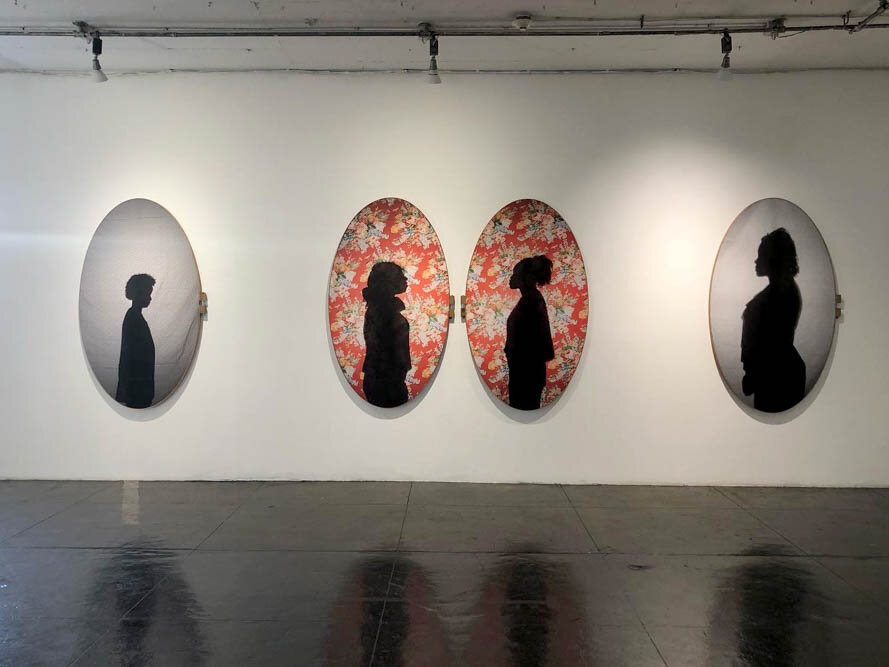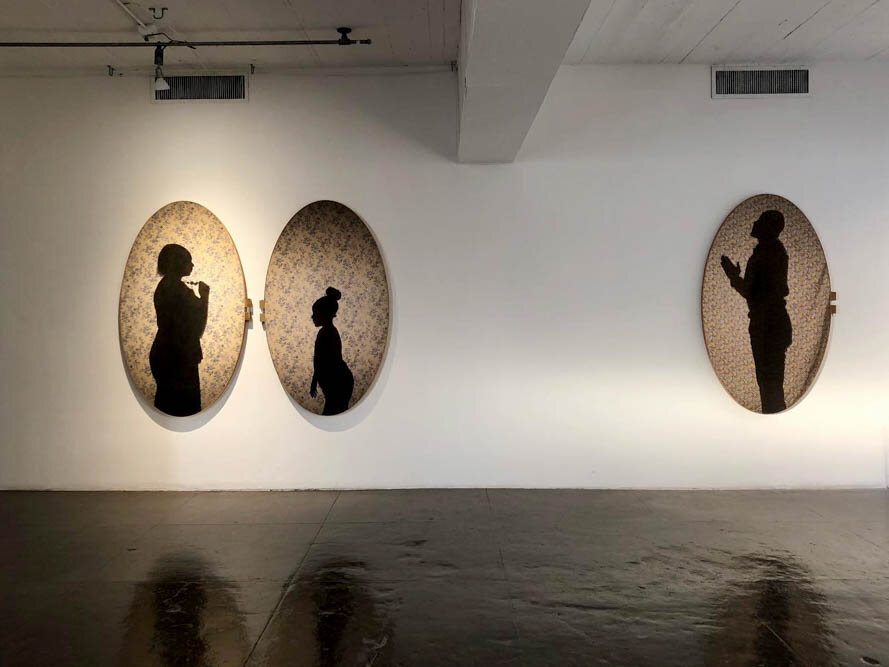And Thy Neighb(our): Local Artist Highlights Immigration within the Black Community
Letitia Huckaby’s And Thy Neighb(our) showcases 15 different individual stories of immigration within the Black community. Courtesy Images: Letitia Huckaby.
January 7, 2021 - San Antonio
By: Valeria Torrealba - Staff Intern, San Antonio Sentinel
For artist Letitia Huckaby’s latest art exhibit, And Thy Neighb(our), the concept of immigration within the Black community is portrayed with a selection of colorful and vintage embroidery, depicting the mesmerizing stories of 15 individuals who left their homes in hopes of a better future in the United States.
As described by Artpace, where the exhibition currently resides, each subject from the work of art depicts an aura of humanity. The “sensitive” approach demonstrates each one’s “personal identity, experiences, and, indeed, their spirit.” Each of the subjects portrayed in Huckaby’s work resides within the San Antonio area.
“It is a project about immigrants and refugees that live in the San Antonio area, but specifically immigrants of African descent, from predominantly Black countries,” Huckaby said. “They range in ethnicity from Ghana, Ethiopia, and there’s a few Haitians [as well]. [There are] a couple of Nigerians, [people from] Rwanda, Kenya, it’s a mix.”
Huckaby sourced her subjects from within her own community in San Antonio. A project that had started as a simple exploration of the people surrounding her quickly evolved into a platform which gave a voice to another struggle the Black community is faced with.
“It took a few weeks of my residency just to build those connections and build that trust,” Huckaby said. “It was really word of mouth and showing them all the work I’ve done before, and people recommending possible [subjects]. As an African-American, my work tends to deal with my culture and my ancestry. I love lacing in the sort of historical aspect, so I wanted to talk about immigration.”
Often times, the subject of immigration is largely saturated by the Latinx community, leaving the Black community, and their stories, overlooked. As described by Artpace, “Much of current immigration news centers on persons crossing the U.S./Mexico border. However, in photographing Black subjects, Huckaby presents those whose experiences may not be as visible but are nevertheless shortchanged and abused at every step of the immigration process.”
Huckaby sought to show that the Black community faces the common struggles of immigration, and that they, too, have their own stories to tell. Many of her subjects immigrated to the U.S. in order to seek a better life and more opportunities, many of whom are leading successful lives within San Antonio today.
“These past few years have been sort of tumultuous and [there has been] a lot of conversation about immigration but no dialogue about the experiences of people of color, people from Black countries. I really wanted to show them as really beautiful and as an important part of society, because there’s so much negativity in the country lately, so much fear of immigration and of the other.”
Huckaby alludes to the stigma surrounding immigrants and immigration in general. For far too long, immigration has been demonized. Those of different cultural backgrounds face the difficulties of assimilation and adapting to a different style of living in hopes to blend in with the community, ultimately leading to the silencing of their own stories.
“It’s been such a hot topic these last few years, but we never really delve into the experiences of immigrants from predominantly Black countries. I wanted to show them in a light that really celebrated their diversity, celebrated all the walks of life that they come from, and show them just as regular people –– not something to be afraid of or to fear as other. They’re people of faith, they’re people with families. There’s a seamstress and her daughter, students, survivors of tragedy… Every walk of life is presented in that body of work, and I wanted to present them as grand and beautiful at the same time.”
“These past few years have been sort of tumultuous and [there has been] a lot of conversation about immigration but no dialogue about the experiences of people of color, people from Black countries. I really wanted to show them as really beautiful and as an important part of society, because there’s so much negativity in the country lately, so much fear of immigration and of the other.” - Letitia Huckaby
When asked about a particular story that moved her, Huckaby retold the heartwarming story of Bethlie and Naika Etienne –– two young girls from Haiti whose legs faced amputation, but were flown out to San Antonio and ultimately recovered. After facing the devastating aftermath of the 2010 Haiti earthquake, the two sisters were able to lead normal lives within the U.S., a story immortalized with Huckaby’s work.
“Those two girls, those two young ladies, came to the States when they were just 10 years old after the earthquake hit in Haiti,” Huckaby said. “Their legs were injured. It was believed that they were going to have to have amputations, but because they were able to come to the States, they were able to get the medical care that’s available here. They were able to save their legs. They are beautiful young women. That story really just struck me.”
The Etienne sisters’ story moved Huckaby as she described the joy and triumph that immigration can bring to a family.
“It’s one of those triumphs of immigration, one of those stories that has that happy ending when you think about immigration and the positives that come out of it, with the people who try to get here for different reasons –– to have a different life, to do things for their children, to just be the family they want to be,” Huckaby said.
Huckaby’s choice of an elaborate embroidery medium for the exhibit was strategic to her roots and upbringing. After losing her father, she detailed the shift in her work focus, seeking to immortalize the stories she presents with beautiful and intricate pieces of embroidery that fit the stories attached to them. For And Thy Neighb(our), Huckaby utilized the fabric as a way to “bridge the gap” between cultures and ultimately demonstrate the relatability of immigration on the Black community.
“After I lost my father, my work shifted. I sort of got interested in being able to layer in history into my work. I do a lot of vintage and heirloom in my fabric work. I love the way the images turn out when they’re printed on fabric. Fabric bridges the gap between cultures –– everyone can relate fabric to an old quilt or an old blanket. You don’t have to be a person of color to get it. I often get people saying that it reminds them of being in their grandmother’s house.”
Aside from emphasizing the beauty and success stories of immigration within the Black community, the embroidery chosen by Huckaby also represents the delicacy and tradition behind each individual subject portrayed.
“All of my work is now photo-based but printed on fabric. I’ve also lately been obsessed with embroidery hoops, using them as frames. They speak to me about how a woman makes something precious for her own,” Huckaby said. “Usually, when someone pulls out the embroidery hoops, they’re not usually making a dish towel, they’re making something that they expect will be passed down through generations.”
Huckaby focuses on immigration within the Black community in order to amplify those voices and share a piece of history from her own community in San Antonio. Through her eccentric and delicate artwork, she showcases the moving and touching stories of people whose voices are often spoken over –– even if the issue is something as universal as the topic of immigration.
“I’m African American, and my ancestors were brought here as slaves. The work that I do focuses on that experience. When I started in photography, I started as a documentary photographer. I was very interested in telling other people’s stories. I only shifted into my own personal story after I had lost my father, but recently, I think that I have been going back to my roots as a documentary photographer, but similar to the vein of the work I have become known for,” said Huckaby. “That’s why I’ve talked about immigration from the Black community.”
Valeria Torrealba is an opinions columnist and public relations assistant at the University Star, a student publication of Texas State University. Email her at reporter@sasentinel.com




